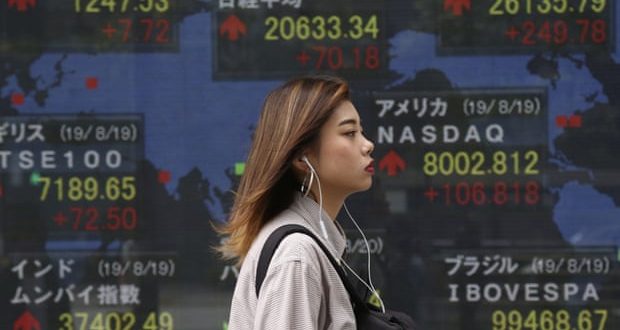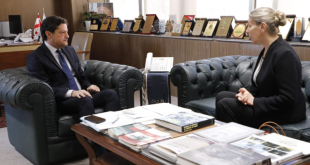President tweets demand for 1% reduction and more QE as markets look to central banks to bolster global economy
Stock markets have been boosted by the growing prospect of more stimulus measures by central banks and governments across the world as Donald Trump heaped more pressure on the Federal Reserve to slash interest rates.
Despite his claims that the US economy was doing “tremednously well”, the US president stepped up his campaign to force Fed chairman Jerome Powell to reduce borrowing costs by a full percentage point to encourage growth.
Trump even suggested the Fed might also reintroduce the controversial policy of quantitative easing, or money printing, which was pioneered when the global financial system collapsed in 2008.
Trump’s latest intervention to force Powell’s hand – which he appeared to link explicitly to his campaign for reelection in 2020 – saw stocks in Asia Pacific rise on Tuesday on the back of gains on Wall Street the previous day.
The Nikkei in Tokyo was up 0.4%, the ASX200 in Sydney rose 0.7% and the Kospi in Seoul jumped 0.4%. However, shares in Hong Kong and Shanghai were down. The FTSE100 was expected to open down slightly at the opening of trade on Tuesday.
The gains went towards reversing losses suffered last week when billions of dollars were wiped from share values amid concerns about the US-China trade war, a possible US recession and a crystallising slowdown in China aand Germany.
The latter two countries have been quick to react. Beijing eased corporate borrowing costs on Tuesday by introducing a new benchmark lending rate and the German finance minister suggested on Monday that the government could dip into its coffers and splurge up to €50bn (£45.7bn) of extra spending.
“There are expectations for looser monetary policy everywhere in the world, and this is cushioning the markets against recent uncertain developments,” said Masayuki Kichikawa, chief macro strategist at Sumitomo Mitsui Asset Management said in Tokyo.
“China is prepared to do a lot for its economy. I hope to hear more about fiscal spending in Germany. Central banks have no choice but to ease. The remaining question is what comes from fiscal policy.”
But investors now overwhelmingly expect the Fed to cut rates again at its 17-18 September policy meeting. The Fed cut rates in July for the first time in a decade to mitigate the effects of the US-China trade row and a global slowdown. The rate is very low by historic standards but nearly two points higher than the years after the 2008 crisis when it fell to 0.5%.
Analysts will now shift their focus to the release of minutes of the Fed’s July meeting which are due out on Wednesday. Traders are also keenly waiting on the Fed’s Jackson Hole seminar and G7 summit in Biarritz this weekend for clues on what additional steps policymakers will take to bolster growth.
John Abernethy, Clime Asset Management in Australia, predicted that the Fed would go one step further and reintroduce quantitative easing as the US budget deficit continues to blow out in the ake of Trump’s tax cuts.
“President Trump has begun to coerce the Fed into cutting cash rates further, and the Fed will succumb and justify their decision by focusing on slowing world economic growth,” he told livewire.com.au. “Indeed, it is possible given the mess that has been created by both the trade war and QE, that the Fed may move quicker than many are currently forecasting.”
The Guardian
 Lebanese Ministry of Information
Lebanese Ministry of Information



